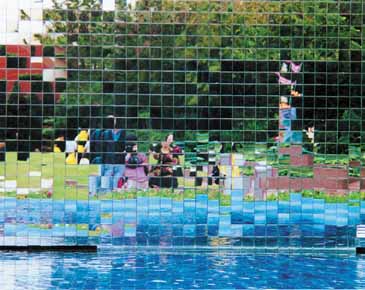
First Place - Natural Category
Broken
Scenery
Jessica Levasseur and Kaidi Liu, Naperville Central
H.S., 440 Aurora Ave., Naperville, IL 60540
Teacher: Christine
Pietrykowski
The virtual image on the photo, unlike that of plane
mirrors used in homes, is not a symmetric inverse image. The reason is
that each tile on the wall acts as a single mirror. Each is inclined at a
different angle, so the mirrors are not coplanar. Therefore, the normals
of each tile are not parallel to each other, which results in different
degrees of angles of reflection. So the virtual image formed on each tile
does not form properly as a whole. The fact that each mirror shows a
different angle of the picture explains why the picture does not appear
identical. Each individual part in each mirror, though, is completely
identical to the original image.
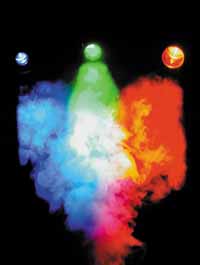
First Place - Contrived Category
Color
Mixing
Caitlin Morgan, John Burroughs School, 755 S. Price Rd.,
St. Louis, MO 63124
Teacher: J. Mark Schober
It is obvious that
there are only three different colors of light, but in the middle of the
three beams, there is a big white spot. Why? Blue, red, and green are the
additive primary colors. Below the white spot in the picture, blue and red
mix to create magenta. To the right of the white spot, red and green mix
to create yellow. And to the left of the white spot, blue and green mix to
create cyan. When looking at the mixture of these three colors from a
distance, the mixtures of the spots provide a complete range of colors,
including white. Therefore, when the three beams of light intersect in the
picture, the white spot becomes apparent.
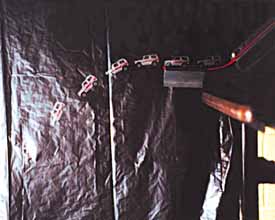
White Bronco Projectile Motion
Aaron Gutting, John Burroughs School, 755 S. Price Rd., St. Louis, MO 63124
Teacher: J. Mark Schober
I launched a small car off a ramp. To capture multiple images of the car, I placed a strobe light to the side of the setup, left the shutter open for half a second, and then launched the car. The car gains velocity as it rolls down the ramp. After the car has left the ramp, its horizontal velocity remains constant. After the car has left the ramp, there is no normal force, so the net gravitational force accelerates it in the Y direction, resulting in the shown parabolic motion. Also, when the front wheels leave the ramp, the resulting torque begins the car rotating. After the car leaves the ramp, there is no net torque, and the car rotates with a constant angular velocity of about 20 degrees per image.
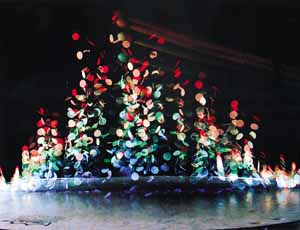
Dancing Paper Bits on Drumhead
Sharon M. Roberson and Elizabeth L. Whitlock, North Carolina School of Science and Mathematics, 1219 Broad St., Durham, NC 27715
Teacher: Loren Winters
We used a computer to set off eight flashes covered with colored cellophane in a rainbow sequence, 5.5 milliseconds apart. When we hit the drum, a sound trigger picked up the sound and sent a signal to the computer interface to set off the flashes. The circles are white paper bits from a hole punch.
We produced an antinode at the center of the drum where we hit it, thereby making the paper bits jump up the highest at that point. Toward the boundary of the drum, the displacement of the bits was the least, showing the presence of a node at the edge of the drum.
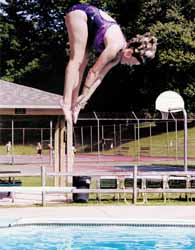
The Physics of a Dive
Rebecca R. Evans, Springbrook H.S., 201 Valleybrook Dr., Silver Spring, MD 20904
Teacher: Nazish Habib
From the time the diver jumps from the board, up until the moment of suspension (shown in picture), the diver is building up potential energy. Upon descending, the diverís kinetic energy increases and the potential energy decreases. The diverís kinetic energy, right before she hits the water, should be the same amount as the potential energy at the moment of suspension. This is the law of conservation of energy.
Newtonís third law is also demonstrated in this photo. As the diver exerts a force on the diving board, the diving board exerts a force on the diver, giving her enough energy to suspend in air and execute the dive.
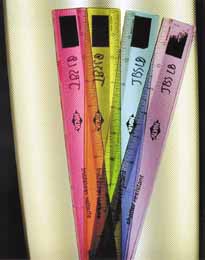
Color Mixing by Subtraction
Jenny Lowe, John Burroughs School, 755 S. Price Rd., St. Louis, MO 63124
Teacher: J. Mark Schober
Each ruler has a different color, but when mixed, they transmit a spectra of color not limited to the four original. This is due to subtractive color mixing. Take, for example, the green color transmitted. When cyan and yellow rulers are combined, they make green. This is because the cyan ruler absorbs all the colors except green and blue. The yellow ruler absorbs all the colors except red, orange, yellow, and green. Therefore, green will be the color seen because color is determined by the particular frequency of light being transmitted. Subtractive coloring is commonly used with paints, inks, and dyes.
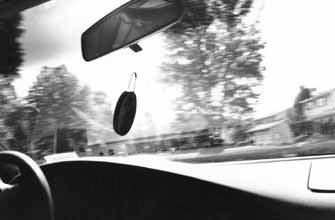
Untitled
Drew Altdoerffer, Whitesboro H.S., 6000 State Route 291, Marcy, NY 13403
Teacher: Ralph Greco
The object, which is hanging from the carís rearview mirror, is leaning toward the left side of the car while the car turns right. This happens due to the objectís tendency to want to continue in a straight line while the car rounds a turn due to its inertia. The reason for this is the carís path in a circular direction to the right while the object hanging from the mirror has an inertial need to continue straight in the absence of an outside force.

Rainbows
Megan Stringer, Broadneck H.S., 1265 Green Holly Dr., Annapolis, MD 21401
Teacher: Allison Hapka
Rainbows are created by the refraction and reflection occurring within raindrops in the atmosphere. Sunlight that is incident on the raindrop is refracted. The separation of colors in the rainbow is the result of dispersion, the separation of light into a spectrum. Each color is refracted at slightly different angles. At the back surface of the raindrop the sunlight undergoes total internal reflection. When leaving the raindrop, the light is once more refracted and dispersed.
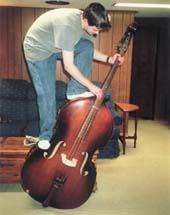
A Balancing Act
Melissa Dunigan, Homewood-Flossmoor H.S., 999 Kedzie Ave., Flossmoor, IL 60422
Teacher: Thomas Cavanaugh
When Mike stands on his string bass, a center of mass exists for the two of them together. He needs to position the combined center of mass of himself and his bass in such a way that it is perpendicular to the spot that the bass touches the ground. Then he balances.
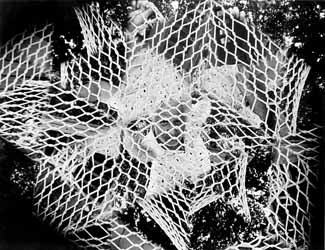
Net
Ashley Solomon, Glenbrook North H.S., 2300 Shermer Rd., Northbrook, IL 60062
Teacher: Nathan A. Unterman
This picture was taken using three mirrors in front of the lens. These three mirrors formed an equilateral triangle. The base made a 30į angle with the horizontal. The man is framed by this primary triangle. At each corner, there are multiple reflections of reflections! As you can see, the bottom half of the manís body is reflected on the top of his head. It also appears that this person is floating in the trees. This too is a result of the three mirrors, multiple reflections.